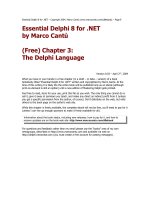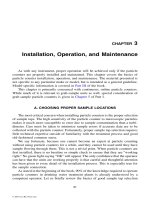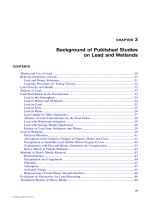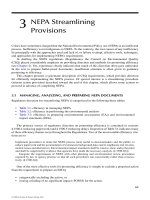Chapter 3 arithmetic for computers
Bạn đang xem bản rút gọn của tài liệu. Xem và tải ngay bản đầy đủ của tài liệu tại đây (2.12 MB, 56 trang )
Computer Architecture
Chapter 3: Arithmetic for Computers
Dr. Phạm Quốc Cường
Adapted from Computer Organization the Hardware/Software Interface – 5th
Computer Engineering – CSE – HCMUT
1
Arithmetic for Computers
• Operations on integers
– Addition and subtraction
– Multiplication and division
– Dealing with overflow
• Floating-point real numbers
– Representation and operations
Chapter 3: Computer Arithmetic - Dr. Cuong
Pham-Quoc
2
Integer Addition
• Example: 7 + 6
• Overflow if result out of range
– Adding +ve and –ve operands, no overflow
– Adding two +ve operands
• Overflow if result sign is 1
– Adding two –ve operands
• Overflow if result sign is 0
Chapter 3: Computer Arithmetic - Dr. Cuong
Pham-Quoc
3
Integer Subtraction
• Add negation of second operand
• Example: 7 – 6 = 7 + (–6)
+7:
–6:
+1:
0000 0000 … 0000 0111
1111 1111 … 1111 1010
0000 0000 … 0000 0001
• Overflow if result out of range
– Subtracting two +ve or two –ve operands, no overflow
– Subtracting +ve from –ve operand
• Overflow if result sign is 0
– Subtracting –ve from +ve operand
• Overflow if result sign is 1
Chapter 3: Computer Arithmetic - Dr. Cuong
Pham-Quoc
4
Dealing with Overflow
• Some languages (e.g., C) ignore overflow
– Use MIPS addu, addui, subu instructions
• Other languages (e.g., Ada, Fortran) require
raising an exception
– Use MIPS add, addi, sub instructions
– On overflow, invoke exception handler
• Save PC in exception program counter (EPC) register
• Jump to predefined handler address
• mfc0 (move from coprocessor reg) instruction can
retrieve EPC value, to return after corrective action
Chapter 3: Computer Arithmetic - Dr. Cuong
Pham-Quoc
5
Arithmetic for Multimedia
• Graphics and media processing operates on
vectors of 8-bit and 16-bit data
– Use 64-bit adder, with partitioned carry chain
ã Operate on 8ì8-bit, 4ì16-bit, or 2ì32-bit vectors
SIMD (single-instruction, multiple-data)
• Saturating operations
– On overflow, result is largest representable value
• c.f. 2s-complement modulo arithmetic
– E.g., clipping in audio, saturation in video
Chapter 3: Computer Arithmetic - Dr. Cuong
Pham-Quoc
6
Multiplication
ã Start with long-multiplication approach
multiplicand
multiplier
product
1000
ì 1001
1000
0000
0000
1000
1001000
Length of product is
the sum of operand
lengths
Chapter 3: Computer Arithmetic - Dr. Cuong
Pham-Quoc
7
Multiplication Hardware
Initially 0
Chapter 3: Computer Arithmetic - Dr. Cuong
Pham-Quoc
8
Example
• Using 4-bit numbers, multiply 210x310
Chapter 3: Computer Arithmetic - Dr. Cuong
Pham-Quoc
9
Optimized Multiplier
• Perform steps in parallel: add/shift
• One cycle per partial-product addition
– That’s ok, if frequency of multiplications is low
Chapter 3: Computer Arithmetic - Dr. Cuong
Pham-Quoc
10
Faster Multiplier
• Uses multiple adders
– Cost/performance tradeoff
• Can be pipelined
– Several multiplication performed in parallel
Chapter 3: Computer Arithmetic - Dr. Cuong
Pham-Quoc
11
MIPS Multiplication
• Two 32-bit registers for product
– HI: most-significant 32 bits
– LO: least-significant 32-bits
• Instructions
– mult rs, rt
/
multu rs, rt
• 64-bit product in HI/LO
– mfhi rd
/
mflo rd
• Move from HI/LO to rd
• Can test HI value to see if product overflows 32 bits
– mul rd, rs, rt
• Least-significant 32 bits of product –> rd
Chapter 3: Computer Arithmetic - Dr. Cuong
Pham-Quoc
12
Division
• Check for 0 divisor
• Long division approach
quotient
– If divisor ≤ dividend bits
dividend
1001
1000 1001010
-1000
divisor
10
101
1010
-1000
10
remainder
n-bit operands yield n-bit
quotient and remainder
• 1 bit in quotient, subtract
– Otherwise
• 0 bit in quotient, bring down
next dividend bit
• Restoring division
– Do the subtract, and if
remainder goes < 0, add
divisor back
• Signed division
– Divide using absolute values
– Adjust sign of quotient and
remainder as required
Chapter 3: Computer Arithmetic - Dr. Cuong
Pham-Quoc
13
Division Hardware
Initially divisor
in left half
Initially dividend
Chapter 3: Computer Arithmetic - Dr. Cuong
Pham-Quoc
14
Example
• Using 4-bit numbers, let’s try dividing 710 by 210
Chapter 3: Computer Arithmetic - Dr. Cuong
Pham-Quoc
15
Optimized Divider
• One cycle per partial-remainder subtraction
• Looks a lot like a multiplier!
– Same hardware can be used for both
Dividend (initially)
Reminder (finally) Quotient (finally)
Chapter 3: Computer Arithmetic - Dr. Cuong
Pham-Quoc
16
Faster Division
• Can’t use parallel hardware as in multiplier
– Subtraction is conditional on sign of remainder
• Faster dividers (e.g. SRT division, use a backup
table instead of restoring) generate multiple
quotient bits per step
– Still require multiple steps
Chapter 3: Computer Arithmetic - Dr. Cuong
Pham-Quoc
17
MIPS Division
• Use HI/LO registers for result
– HI: 32-bit remainder
– LO: 32-bit quotient
• Instructions
– div rs, rt / divu rs, rt
– No overflow or divide-by-0 checking
• Software must perform checks if required
– Use mfhi, mflo to access result
Chapter 3: Computer Arithmetic - Dr. Cuong
Pham-Quoc
18
Floating Point
• Representation for non-integral numbers
– Including very small and very large numbers
ã Like scientific notation
2.34 ì 1056
+0.002 × 10–4
– +987.02 × 109
normalized
not normalized
• In binary
– ±1.xxxxxxx2 × 2yyyy
• Types float and double in C
Chapter 3: Computer Arithmetic - Dr. Cuong
Pham-Quoc
19
Floating Point Standard
• Defined by IEEE Std 754-1985
• Developed in response to divergence of
representations
– Portability issues for scientific code
• Now almost universally adopted
• Two representations
– Single precision (32-bit)
– Double precision (64-bit)
Chapter 3: Computer Arithmetic - Dr. Cuong
Pham-Quoc
20
IEEE Floating-Point Format
• S: sign bit (0 non-negative, 1 negative)
• Normalize significand: 1.0 ≤ |significand| < 2.0
– Always has a leading pre-binary-point 1 bit, so no need to represent it
explicitly (hidden bit)
– Significand is Fraction with the “1.” restored
• Exponent: excess representation: actual exponent + Bias
– Ensures exponent is unsigned
– Single: Bias = 127; Double: Bias = 1203
single: 8 bits
double: 11 bits
S Exponent
single: 23 bits
double: 52 bits
Fraction
x ( 1)S (1 Fraction) 2(Exponent Bias)
Chapter 3: Computer Arithmetic - Dr. Cuong
Pham-Quoc
21
Single-Precision Range
• Exponents 00000000 and 11111111 reserved
• Smallest value
– Exponent: 00000001
actual exponent = 1 – 127 = –126
– Fraction: 000…00 significand = 1.0
– ±1.0 × 2–126 ≈ ±1.2 × 10–38
• Largest value
– exponent: 11111110
actual exponent = 254 – 127 = +127
– Fraction: 111…11 significand ≈ 2.0
– ±2.0 × 2+127 ≈ ±3.4 × 10+38
Chapter 3: Computer Arithmetic - Dr. Cuong
Pham-Quoc
22
Double-Precision Range
• Exponents 0000…00 and 1111…11 reserved
• Smallest value
– Exponent: 00000000001
actual exponent = 1 – 1023 = –1022
– Fraction: 000…00 significand = 1.0
– ±1.0 × 2–1022 ≈ ±2.2 × 10–308
• Largest value
– Exponent: 11111111110
actual exponent = 2046 – 1023 = +1023
– Fraction: 111…11 significand ≈ 2.0
– ±2.0 × 2+1023 ≈ ±1.8 × 10+308
Chapter 3: Computer Arithmetic - Dr. Cuong
Pham-Quoc
23
Floating-Point Precision
• Relative precision
– all fraction bits are significant
– Single: approx 223
ã Equivalent to 23 ì log102 23 ì 0.3 ≈ 6 decimal digits of
precision
– Double: approx 2–52
• Equivalent to 52 × log102 ≈ 52 × 0.3 ≈ 16 decimal digits
of precision
Chapter 3: Computer Arithmetic - Dr. Cuong
Pham-Quoc
24
Real to IEEE 754 Conversion
• Step 1: Decide S
• Step 2: Decide Fraction
– Convert the integer part to Binary
– Convert the fractional part to Binary
– Adjust the integer and fractional parts according
the Significand format (1.xxx)
• Step 3: Decide exponent
Chapter 3: Computer Arithmetic - Dr. Cuong
Pham-Quoc
25









